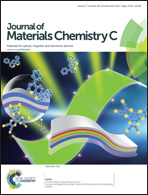Bipolar host materials for high-efficiency blue phosphorescent and delayed-fluorescence OLEDs†
Abstract
A series of small molecular isomers, namely o-CzCN, m-CzCN, and p-CzCN, are developed for use as bipolar hosts in blue phosphorescent and fluorescent organic light-emitting diodes (OLEDs). Cyano (CN) substituted phenyl is selected as the n-type unit and N-phenyl-substituted carbazole as the p-type unit. By adjusting the ortho-, meta-, and para-linking styles of the functional units, the physical parameters are regularly tuned to a large extent. The study of complete spatial separation of frontier molecular orbitals and single-carrier devices confirm the bipolar feature. Blue phosphorescent and thermally activated delayed fluorescence (TADF) OLEDs were fabricated using iridium(III)bis(4,6-(difluorophenyl)pyridinato-N,C2′)picolinate (FIrpic) and 1,2-bis(carbazol-9-yl)-4,5-dicyanobenzene (2CzPN) as doped emitters. A maximum current efficiency of 46.81 cd A−1 and an external quantum efficiency of 23.14% were achieved for the phosphorescent OLED with the m-CzCN host. Furthermore, high efficiencies of 29.23 cd A−1 and 14.98% were obtained for the 2CzPN based blue TADF device with the o-CzCN host, which are higher than the best literature value of 13.6% for 2CzPN devices. Both m-CzCN and o-CzCN always perform better than p-CzCN. The influence of the chemical structures on their properties and performance is interpreted for these CN-decorated host materials.


 Please wait while we load your content...
Please wait while we load your content...